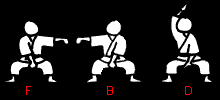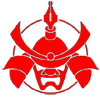About the Semaphore Kata
In the Fudebakudo semaphore kata, every move has meaning.
- What difference does the Karate and Taekwondo setting make?
-
Karate kata are performed in a wrap-around jacket. Taekwondo poomse are performed in a fashionable V-neck.
- And how about hide letters?
-
By default little red letters spell out the kata while it is performed (this is a modern innovation). Click the checkbox if you don't want to see them.
- Can you explain the Semaphore Kata?
-
Semaphore is a system of signalling the letters of the alphabet using hand positions. In real application, flags are used to make the signal clearer. In the Fudebakudo semaphore kata, the flags (like the opponent) are implied.

Traditionally, noncombative semaphore is performed with the legs straight. In American systems, double letters are indicated by a bend of the knees, whereas in Britain the hands are dropped between duplicate letters. In the Fudebakudo semaphore kata, the knees are generally kept bent, and the body weight is shifted according to the demands of the stance — sometimes incorporating a kick without affecting the meaning conveyed by the arm position.
Kata (and, in Korean systems, poomse) are usually a set of prescribed but nonetheless arbitrary movements, often simulating combat against a number of imaginary opponents. Students often wonder, "why make this move now?" The Fudebakudo semaphore kata is not arbitrary — the positions and their order is defined by basic rules of spelling and grammar. Complex Fudebakudo semaphore kata, while remaining deadly in application, are choreographed to produce short poems (usually haiku revealing profound Oriental wisdom, but sometimes less profound "infantry" limericks).
- Does this mean that kata I already know may have a hidden meaning?
-
Since Fudebakudo first revealed the underlying method of kata formation with its semaphore kata, a number of scholars have re-evaluated many of the better known kata from traditional karate styles. Some commentators have gone so far as to suggest this approach is the martial arts' "new Bible Code." Disappointingly, this is unlikely to be the case. The kata taught today by the most traditional karate ryu originate from a time when kata were based on kanji rather than Roman letters. The kanji semaphore system used at the turn of the 17th century, when many of these kata were first conceived, contained over 10,000 different arm positions and used five different flags, with some dialects, notably those from northern prefectures as well as Okinawa itself, using arms bent at the elbow as well. This makes readings of old Japanese kata somewhat difficult to the untrained eye. It is possible that the advances Fudebakudo has made to the understanding of kata will have come too late for many traditional kata, and the messages the Old Masters were trying to convey will have been lost forever.

